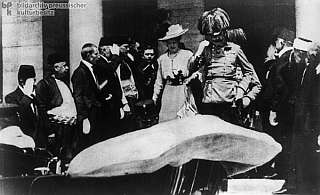
Franz Ferdinand and his wife Sophie leave the Sarajevo Town Hall on 28 June 1914, five minutes before the assassination.
The Good Soldier Švejk is a novel with an unusually rich array of characters. In addition to the many who directly form part of the plot, a large number of fictional and real people (and animals) are mentioned; either through the narrative, Švejk's anecdotes, or indirectly through words and expressions.
This web page contains short write-ups on the people that the novel refers to; from Napoléon in the introduction to Hauptmann Ságner in the last few lines of the unfinished Part Four. The list is sorted in the order of which the names first appear. The chapter headlines are from Zenny Sadlon's recent translation (1999-2024) and will in most cases differ from Cecil Parrott's version from 1973.
The quotes in Czech are copied from the on-line version of The Good Soldier Švejk: provided by Jaroslav Šerák and contain links to the relevant chapter. The toolbar has links for direct access to Wikipedia, Google maps, Google search, svejkmuseum.cz and the novel on-line.
The names are coloured according to their role in the novel, illustrated by the following examples:
- Dr. Grünstein as a fictional character who is directly involved in the plot.
- Fähnrich Dauerling as a fictional character who is not part of the plot.
- Heinrich Heine as a historical person.
Note that a number of seemingly fictional characters are inspired by living persons. Examples are Oberleutnant Lukáš, Major Wenzl and many others. This are still listed as fictional because they are literary creations that are only partly inspired by their like-sounding "models".
Military ranks and some other titles related to Austrian officialdom are given in German, and in line with the terms used at the time (explanations in English are provided as tooltips). This means that Captain Ságner is still referred to as Hauptmann although the term is now obsolete, having been replaced by Kapitän. Civilian titles denoting profession etc. are translated into English. This also goes for ranks in the nobility, at least where a direct translation exists.
 People index of people, mythical figures, animals ... (588)
Show all
People index of people, mythical figures, animals ... (588)
Show all I. In the rear
I. In the rear  1. The good soldier Švejk acts to intervene in the world war (30)
1. The good soldier Švejk acts to intervene in the world war (30) 14. Švejk as military servant to senior lieutenant Lukáš (35)
14. Švejk as military servant to senior lieutenant Lukáš (35) II. At the front
II. At the front  1. Švejk's mishaps on the train (22)
1. Švejk's mishaps on the train (22) 2. Švejk's budějovická anabasis (55)
2. Švejk's budějovická anabasis (55) 3. Švejk's happenings in Királyhida (46)
3. Švejk's happenings in Királyhida (46) 5. From Bruck on the Leitha toward Sokal (45)
5. From Bruck on the Leitha toward Sokal (45) III. The famous thrashing
III. The famous thrashing  1. Across Magyaria (52)
1. Across Magyaria (52) 2. In Budapest (32)
2. In Budapest (32) 3. From Hatvan to the borders of Galicia (31)
3. From Hatvan to the borders of Galicia (31) 4. Forward March! (32)
4. Forward March! (32) IV. The famous thrashing continued
IV. The famous thrashing continued  1. Švejk in the transport of russian prisoners of war (35)
1. Švejk in the transport of russian prisoners of war (35) 3. Švejk again with his march company (20)
3. Švejk again with his march company (20)



|
I. In the rear |
 | |
2. The good soldier Švejk at police headquarters | |||
 | Detective Brixi |  | ||||
| ||||||
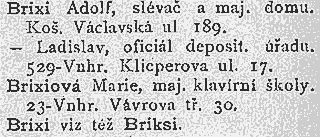
Adresář královského hlavního města Prahy a obcí sousedních (1907)
Brixi was a policeman who arrested an unusually fat paper merchant who had paid for to Serbian students at U Brejšky and had been observed drunk with them at Café Montmartre. The owner of the paper shop was one of Švejk's fellow prisoners at c.k. policejní ředitelství.
Background
This detective may well have had a model from real life but the surname Brixi (including the variant Briksi) was relatively rare in Prague. At most ten people carrying this name were alive at the time and none of them are listed with professions that seem related to the police.
Quote(s) from the novel
[I.2] Výjimku dělal neobyčejně tlustý pán s brýlemi, s uplakanýma očima, který byl zatčen doma ve svém bytě, poněvadž dva dny před atentátem v Sarajevu platil „U Brejšky“ za dva srbské studenty, techniky, útratu a detektivem Brixim byl spatřen v jejich společnosti opilý v „Montmartru“ v Řetězové ulici, kde, jak již v protokole potvrdil svým podpisem, též za ně platil.
 | Columbus, Cristoforo |  | |||
| *1451(?) Genova(?) - †20.5.1506 Valladolid | |||||
| |||||

Columbus breaking the egg
Columbus is mentioned indirectly through the description of the event who led to the arrest of one of Švejk's fellow prisoners. Švejk's fellow inmate was a teacher of history who concluded his analysis of various assassinations with the words: The idea of an assassination is as easy as Columbus' egg.
Background
Columbus was a discoverer and merchant og Italian origin, known for the European "discovery" of America in 1492.
Columbus' egg describes a brilliant idea or discovery that seems simple or easy after the fact. The expression refers to a popular story of how Christopher Columbus, having been told that discovering the Americas was no great accomplishment, challenged his critics to make an egg stand on its tip; and, after they gave up, he did it himself by tapping the egg on the table so as to flatten its tip.
Quote(s) from the novel
[I.2] Malý pán, kterému se to stalo ve vinárně, byl profesorem dějepisu a vykládal vinárníkovi dějiny různých atentátů. Byl zatčen právě v okamžiku, když končil psychologický rozbor každého atentátu slovy: „Myšlenka atentátu je tak jednoduchá jako, Kolumbovo vejce’.“
Also written:KolumbusczKolumbusdeCristóbal ColónesColumbusnn
 | Jesus Christ |  | |||
| *4 f.kr(?) Betlehem - †30(?) Jersusalem | |||||
| |||||

As seen by El Greco
Jesus Christ is mentioned 38 times in The Good Soldier Švejk.
Jesus Christ is referred to by Švejk as "Kristus Pán", literally "Christ the Lord". This is when he tells his fellow prisoners about their hopeless situation. "Christ the Lord was also innocent" are the discouraging words they hear. Jesus is mentioned more peripherally in the first chapter, through the expression Ježíšmarjá that Švejk used when he heard about the killings in Sarajevo. Jesus is mentioned at various stages through the novel, mostly in common expressions. The words used are Ježíš or Kristus/Krist. There are also rare occurences of the German Jesus and the Hungarian Krizstus.
Background
Jesus Christ was a central figure in the Bible. He laid the foundations of the Christian faith. He was crucified for instigating rebellion in the year of 33 during the period of Roman rule. His birth and death dates are most uncertain. According to the Cristian faith and his own claims he was the Son of God and Messiah the Saviour. Jesus was also an important prophet in islam but this religion credits him with a less important role. The Jewish religion regards him as a false Messiah.
Quote(s) from the novel
[I.2] „Já jsem nevinnej, já jsem nevinnej,“ opakoval zježený muž. „Kristus Pán byl taky nevinnej,“ řekl Švejk, „a taky ho ukřižovali. Nikde nikdy nikomu na nějakým nevinným člověku nezáleželo. Maul halten und weiter dienen!, jako říkávali nám na vojně. To je to nejlepší a nejkrásnější.“
[I.15] "Co s ním udělám?" mihlo se hlavou nadporučíkovi, "má, prokristapána, takový pitomý výraz."
[I.15] "Švejku, ježíšmarjá, himlhergot, já vás zastřelím, vy hovado, vy dobytku, vy vole, vy hajzle jeden. Jste tak blbej?"
[II.3] "Ježíšmarjá", vzdychl pro sebe desátník, vida, že po důkladném loku zmizelo půl láhve.
[II.3] "Mají to tady pěkně zařízený, dokonce dva deštníky na věšáku, a ten vobraz toho Pána Krista taky není špatnej."
[II.3] "Baszom az anyát, baszom az istenet, baszom a Krizstus Márját, baszom az atyádot, baszom a világot!"
[II.4] "Pochválen Pán Ježíš Kristus," řekl vstupuje, načež Švejk za všechny odpověděl: "Až na věky amen."
[II.4] Po pravé straně na stole stál krucifix z napodobené slonoviny, se zaprášeným Kristem, který se zoufale díval na podstavec svého kříže, na kterém byl popel a oharky z cigaret.
Also written:Ježíš Kristuscz
 | Lombroso, Cesare |  | ||||
| *6.11.1835 Verona - †19.10.1909 Torino | ||||||
| ||||||
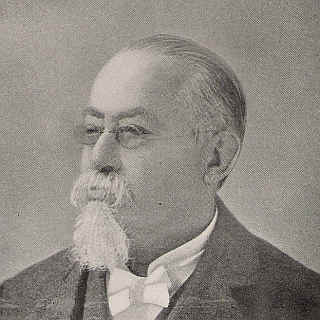
,5.11.1909
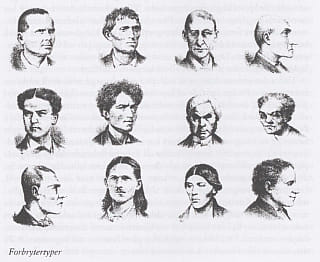
Kampen om den forbryterske sjel, ,2002
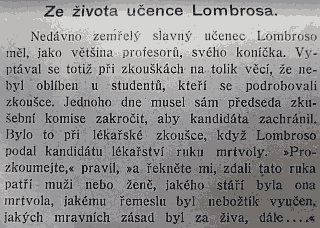
,15.11.1909
Lombroso is referred to in connection with the book About Criminal Types where the author describes the interrogator at c.k. policejní ředitelství. He looked like a criminal type described by Lombroso in this particular book.
Background
Lombroso was an Italian psychologist, criminologist, and anthropologist of Jewish origin, baptised Ezechia Marco Lombroso.. He was a pioneer of anthropological criminology which promoted the claim that criminality was inherited. Lombroso rejected the hitherto classical view that the criminal instinct was part of human nature. His political anthropology criminology maintained that criminal behaviour is in the genes and could be enhanced by physical defects. The physical shape could indicate whether a person was a criminal, which he gave many examples of in the illustrations in his books.
L'uomo delinquente
Lombroso never wrote any book with the title About Criminal Types so the book that Hašek refers to in The Good Soldier Švejk is often believed to be L'uomo delinquente (1876, Criminal Man), his best known publication. Still, there are only a handful of drawings in this book, at least in the first edition, so it may be that Hašek drew inspiration from some of Lombroso's other works. That said, during Lombroso's lifetime five distinct editions appeared and in these more illustrations were added[c].
The book was never translated into Czech so Hašek probably read a German version.
Hašek and Lombroso
Curiously, there is a notice in Svět zvířat about Lombroso at the time when Hašek edited the magazine. It was not signed but literary scholar Radko Pytlík assumes that it was indeed written by Hašek and he is surely right. The notice was of a grotesque nature (a trait that repeatedly appears in Hašek's writing and stories told about him) but had absolutely nothing to do with animals![a]
Lombroso is even quoted directly in the last ever article that Hašek is known to have written for Svět zvířat during his first period as editor (1909-1910). It is called Remove Pain![b] and is one of several testimonies to Hašek's affection for animals and his interest in their welfare.
Quote(s) from the novel
[I.2] „Dobrý večer přeju, pánové, všem vespolek.“ Místo odpovědi dloubl ho někdo pod žebra a postavil před stůl, za kterým seděl pán chladné úřední tváře s rysy zvířecké ukrutnosti, jako by právě vypadl z Lombrosovy knihy „O typech zločinných“. Podíval se krvežíznivě na Švejka a řekl: „Netvařte se tak blbě.“
Literature
- L'uomo delinquente, ,1876
- Lombroso Cesare, ,1900
- Cesare Lombroso, ,1911
- Criminal man, according to the classification of Cesare Lombroso, ,1911
- Lombroso, ,1916
- Lombroso Cesare (1836-1909), ,1947-1948
- Kampen om den forbryterske sjel, ,2002
- Criminal man, tr. Mary Gibson, Nicole Hahn Rafter,2006 [c]
- Ueber Verbrecher-Physiognomien, ,4.4.1887
- Ein geschenckter Menschenkopf, ,13.12.1894
- Ze života učence Lombrosa, ,15.11.1909 [a]
- Odstraňte bolest!, Vladmír Mayer,15.10.1910 [b]
- Cesare Lombroso, ,22.10.1909
| a | Ze života učence Lombrosa | 15.11.1909 | |
| b | Odstraňte bolest! | Vladmír Mayer | 15.10.1910 |
| c | Criminal man | tr. Mary Gibson, Nicole Hahn Rafter | 2006 |
 | Jan Nepomucký |  | ||||
| *1345(?) Nepomuk - †20.3.1391 Praha | ||||||
| ||||||
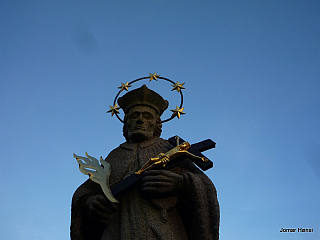
Statue in Třeboň, 2011.
Jan Nepomucký was by Švejk held as an example of how badly prisoners were treated before, compared to the good treatment Švejk and his fellow inmates got these July days in 1914. Our hero falsely claimed that Nepomuk was drowned from Eliščin most. He appears again in the anecdote about Šic in [II.5].
Background
Jan Nepomucký (John of Nepomuk) was a Czech priest and martyr who was blinded, tortured, and drowned in the Vltava. Today there is a statue of him at the point at Karlův most where he was thrown off. He was canonized in 1729 and is now a patron saint. He is buried in Saint Vitus Cathedral in Prague.
Quote(s) from the novel
[I.2] Nebo mu dali nohy do španělský boty a natáhli ho na žebřík, když se nechtěl přiznat, nebo mu pálili boky hasičskou pochodní, jako to udělali svatému Janu Nepomuckému.
Also written:John of NepomukenJohannes NepomukdeJohan Nepomukno
Literature



|
I. In the rear |
 | |
2. The good soldier Švejk at police headquarters | |||
| © 2008 - 2024 Jomar Hønsi | Last updated: 20.11.2024 |


